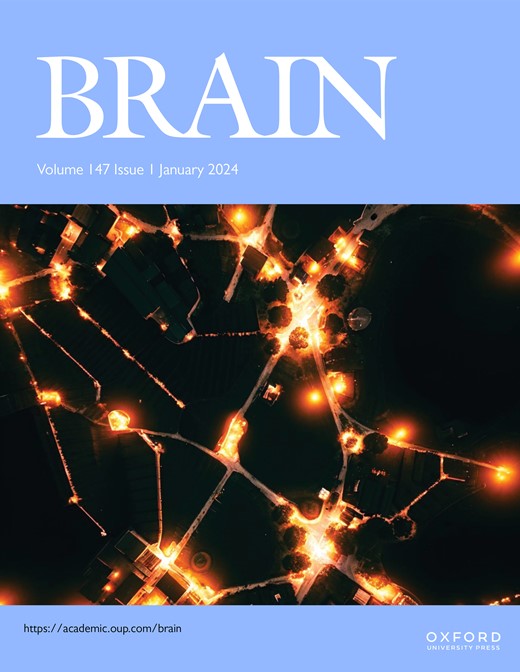Clinical and genetic landscape of optic atrophy in 826 families: insights from 50 nuclear genes
IF 10.6
1区 医学
Q1 CLINICAL NEUROLOGY
引用次数: 0
Abstract
Hereditary optic neuropathies (HON) are a group of diseases due to genetic defects either in mitochondria or in nuclear genomes. The increasing availability of genetic testing has expanded a broader genetic and phenotypic spectrum of HON than previously recognized. To provide systematic insight into the genetic and phenotypic landscape of HON attributed to 50 nuclear genes, we conducted genetic analysis on part of 4776 index patients with clinical diagnosis of HON following our previous study on 1516 probands with Leber hereditary optic neuropathy (LHON) and mitochondrial DNA variants. Exome sequencing was performed in 473 patients diagnosed with nuclear gene-related HON (nHON) and 353 cases with unsolved LHON. Sequencing and variant interpretation in 50 causative nuclear genes indicated that the diagnostic yield of exome sequencing for nHON was 31.50% (149/473), while it was markedly lower at 1.42% (5/353) for LHON patients without primary mtDNA mutations. The top five implicated genes causing nHON in our in-house cohort, OPA1, WFS1, FDXR, ACO2, and AFG3L2, account for 82.46% of mutations. Although OPA1 was the most prevalent causative gene of nHON in both our cohort (53.25%) and literature review (37.09%), the prevalence of OPA1, WFS1, and FDXR differed significantly between our in-house cohort and the literature review (P-adjusted<0.001). Fundus changes in nHON could be stratified into three categories, the most common is optic atrophy at the examination (78.79%), the rarest is LHON-like optic atrophy (3.64%), and the intermediate is optic atrophy with concurrent retinal degeneration (17.57%), which was an independent risk factor for visual prognosis in nHON. A systematic genotype-phenotype analysis highlighted different genetic contributions for ocular, extraocular neurological, and extraocular non-neurological phenotypes. In addition, systemic variant analysis at the individual gene level suggested a revised interpretation of the pathogenicity of a WFS1 heterozygous truncation variant. This study provides a panoramic summary of both the genetic and phenotypic profiles of HON in real-world studies and literature. The category for nHON fundus phenotypes is built for future studies on molecular mechanisms underlying HON and targeted therapies. In addition to routine ophthalmic examinations, careful examination of the extraocular symptoms and meaningful genetic counseling are warranted for patients with nHON.826 个家庭视神经萎缩的临床和遗传情况:从 50 个核基因中获得的启示
遗传性视神经病变(HON)是一组因线粒体或核基因组遗传缺陷而导致的疾病。随着基因检测技术的日益普及,遗传性视神经病变的遗传和表型范围比以前所认识到的更为广泛。为了系统地了解归因于 50 个核基因的 HON 的遗传和表型情况,我们继之前对 1516 名患有 Leber 遗传性视神经病变(LHON)和线粒体 DNA 变异的原发性患者进行研究后,又对 4776 名临床诊断为 HON 的部分指标患者进行了遗传分析。我们对 473 例确诊为核基因相关 HON(nHON)的患者和 353 例未确诊的 LHON 患者进行了外显子组测序。对 50 个致病核基因的测序和变异解读表明,外显子组测序对 nHON 的诊断率为 31.50%(149/473),而对无原发性 mtDNA 变异的 LHON 患者的诊断率则明显较低,仅为 1.42%(5/353)。在我们的内部队列中,导致 nHON 的五大受影响基因 OPA1、WFS1、FDXR、ACO2 和 AFG3L2 占突变的 82.46%。虽然在我们的队列(53.25%)和文献综述(37.09%)中,OPA1 是 nHON 最常见的致病基因,但我们的队列和文献综述中 OPA1、WFS1 和 FDXR 的流行率存在显著差异(P 调整后<0.001)。nHON的眼底变化可分为三类,最常见的是检查时的视神经萎缩(78.79%),最罕见的是LHON样视神经萎缩(3.64%),中间的是视神经萎缩并发视网膜变性(17.57%),这是影响nHON视力预后的独立危险因素。系统的基因型-表型分析强调了眼部、眼外神经系统和眼外非神经系统表型的不同遗传贡献。此外,单个基因水平的系统变异分析表明,WFS1杂合截断变异的致病性解释有所改变。本研究对实际研究和文献中 HON 的遗传和表型特征进行了全景式总结。建立 nHON 眼底表型类别是为了今后研究 HON 的分子机制和靶向治疗。除了常规眼科检查外,还需要对 nHON 患者的眼外症状进行仔细检查并提供有意义的遗传咨询。
本文章由计算机程序翻译,如有差异,请以英文原文为准。
求助全文
约1分钟内获得全文
求助全文
来源期刊

Brain
医学-临床神经学
CiteScore
20.30
自引率
4.10%
发文量
458
审稿时长
3-6 weeks
期刊介绍:
Brain, a journal focused on clinical neurology and translational neuroscience, has been publishing landmark papers since 1878. The journal aims to expand its scope by including studies that shed light on disease mechanisms and conducting innovative clinical trials for brain disorders. With a wide range of topics covered, the Editorial Board represents the international readership and diverse coverage of the journal. Accepted articles are promptly posted online, typically within a few weeks of acceptance. As of 2022, Brain holds an impressive impact factor of 14.5, according to the Journal Citation Reports.
 求助内容:
求助内容: 应助结果提醒方式:
应助结果提醒方式:


